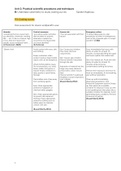Unit 2: Practical scientific procedures and techniques
B: U
ndertake calorimetry to study cooling curves Sanele Maphosa
P3: Cooling curves
Risk assessment f or stearic acid/paraffin wax:
Hazards: Control measures: Assess risk: Emergency action:
“something that can cause harm, “are actions and/or activities The risk associated with that “It should detail step-by-step
e.g. electricity, chemicals, working that are taken to prevent, hazard procedures to follow in emergencies...
late ….. etc. A risk is a chance, high eliminate or reduce the such as fire, chemical spill, or a major
or low, that any hazard will occurrence of a hazard that accident”. ( 7,BD)
actually cause somebody harm ....” you have identified”.
(1,Worksmart, 2020) (6,MyHaccp)
Stearic Acid Avoid contact with eyes, skin, Eye: Causes eye irritation. Eyes: Immediately flush eyes with
and clothing. May cause chemical plenty of water for at least 15
conjunctivitis. minutes, occasionally lifting the upper
Empty containers retain and lower eyelids. Get medical aid.
product residue, (liquid and/or Skin: Causes skin irritation.
vapor), and can be dangerous. May be harmful if absorbed Skin: Get medical aid. Flush skin with
through the skin. plenty of water for at least 15
Wash clothing before reuse. minutes while removing
Do not pressurize, cut, weld, Aspiration of material into the contaminated clothing and shoes.
braze, solder, drill, grind, or lungs may cause chemical
expose empty containers to pneumonitis, which may be Remove from exposure and move to
heat, sparks or open flames. fatal. fresh air immediately. If not breathing,
Storage: May be harmful if swallowed. give artificial respiration.
Inhalation: Causes respiratory
Flammables-area. Keep away tract irritation. Clean up spills immediately,
from oxidizing agents. (8,west liberty,2012) observing precautions in the
Protective Equipment section.Sweep
Eyes: Wear appropriate up, then place into a suitable
protective eyeglasses or container for disposal. Scoop up with
chemical safety goggles a non sparking tool, then place into a
suitable container for disposal. Avoid
Skin: Wear appropriate gloves generating dusty conditions. Remove
to prevent skin exposure. all sources of ignition.
Clothing: Wear appropriate (8,west liberty,2012)
protective clothing such as
safety specs to minimize
contact with skin.
(8,west liberty,2012)
1
, Unit 2: Practical scientific procedures and techniques
B: U
ndertake calorimetry to study cooling curves Sanele Maphosa
The substance paraffin contains Another way to control risk is “The flammability can cause If Paraffin wax spills on clothes or
Steric acid “the proportion of 10% by ensuring “all the danger as flammable liquid skin, emergency action is needed to
stearic acid to 90% wax …... helps equipment needed to put out and vapour may be fatal if take place such as “removing the
moulds release because it makes a fire is accessible and they enter the airways can contaminated clothing and washing
the wax shrink upon cooling….” working e.g. bench mat, and cause drowsiness and the skin with water and soap. Then
(2,Nature Garden,2020) fire blanket” this precaution dizziness”. A suitable control take the contaminated clothes out for
will prevent the fires from measurement for this would the solvent to evaporate”.
spreading. be to stay a certain distance
away when inhaling this will If Paraffin wax spills on clothes or
During cooling curve practical prevent the feeling of skin, emergency action is needed to
we used a bunsen burner to dizziness and not using the take place such as “removing the
melt the Paraffin wax this paraffin near naked flames as contaminated clothing and washing
could be a hazard as the open will cause a wildfire. the skin with water and soap. Then
fire flame can burn at a high take the contaminated clothes out for
temperature which leads to Paraffin is a hydrocarbon so it the solvent to evaporate”.
potential accidents such as has an attractive force
getting burnt.So to control can between hydrogen attached Also if Paraffin wax spills on the floor
place “ Bunsen burner away to an electronegative atom. or desk this results in emergency
from any overhead shelving, As its a hydrocarbon the action this will consist of opening the
equipment.And Remove all potential hazards consist of window to allow fresh air and “ cover
papers, notebooks, the substance being: with mineral absorbance and scoop
combustible materials and “flammable, harmful, health into a bucket, add washing up liquid
excess chemicals from the hazard and environmental and work into an emulsion”.
area. Tie back any long hair, hazard”. However, it’s the (3,Cleapss,2019)
dangling jewelry, or loose least hazardous out of all the
clothing. on the gas valve and other hydrocarbons.
the Bunsen burner
(5,Safety gram,March 2013) .
Another risk is “ skin irritation
may cause damage to organs
through repeated exposure”
to reduce this risk using tiny
amounts as its less contact
and by wearing eye
protection it protects our eye.
Method calibration of a thermometer: cooling point
1) Fill the beaker with ice then add distilled water to cover the ice
2) Stir the water and let it sit for a while
3) Insert the digital thermometer into the breaker making sure don't touch sides because
it affects the temperate results.
4) Then wait for the temperature to stabilize then record the correct precision. Repeat
this three times a minute apart so you can find the average temperature for the
cooling point.
5) Repeat for the Liquid thermometer.
2




